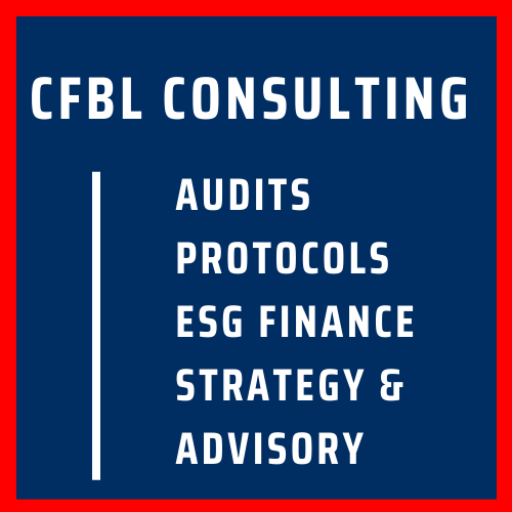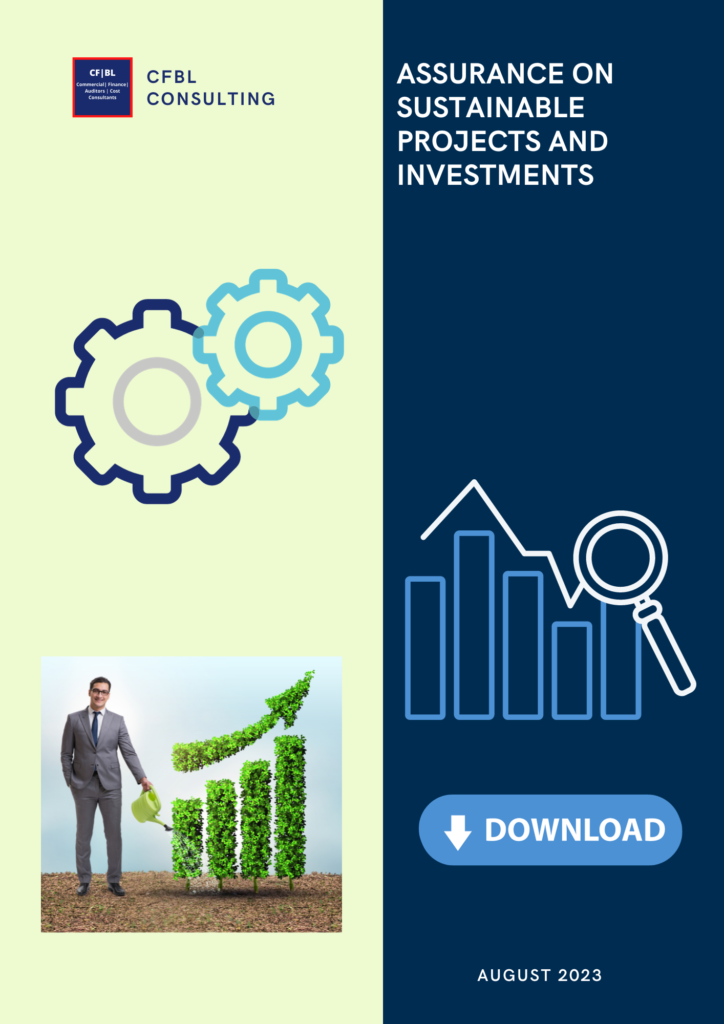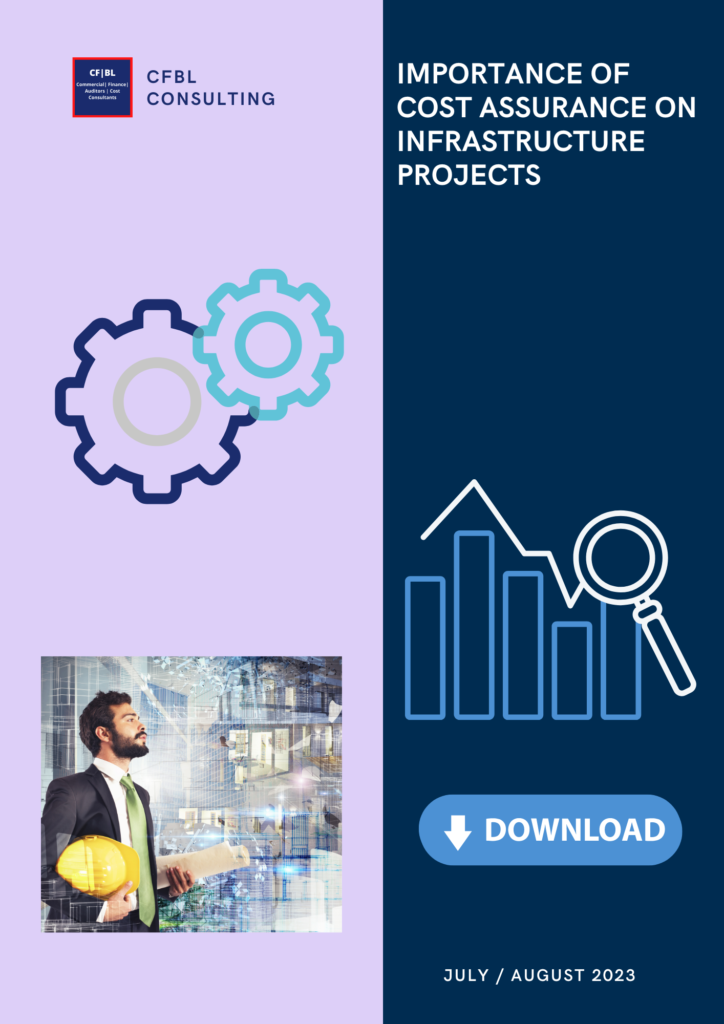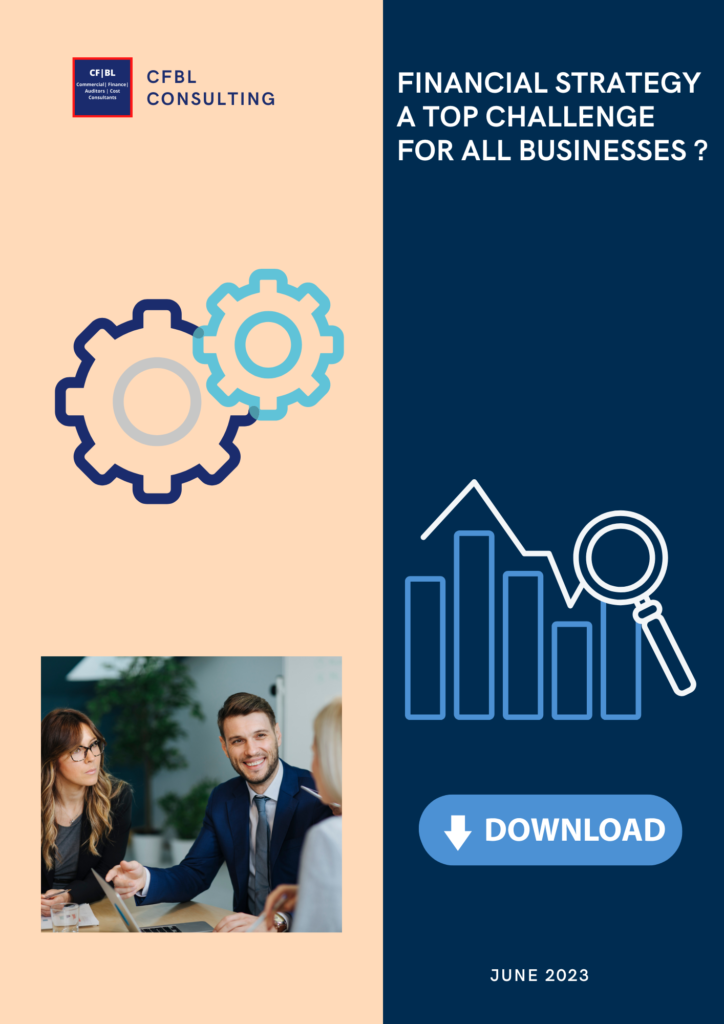-Cecelia Fadipe
Developing a Cost Assurance Strategy
The mission is to provide leaders and funders of infrastructure projects with assurance of cost through a carefully implemented cost assurance strategy that maximises profit and value from capital investments and infrastructure assets sustainably.
Overview
This report offers valuable insights and advice regarding the fundamental principles of a cost assurance strategy. The mission is to provide leaders and funders of infrastructure projects globally across sectors and asset classes with the assurance of cost through a carefully implemented cost assurance strategy that maximises profits and value from capital investments and infrastructure assets sustainably.
What is a Cost Assurance Strategy?
- Cost-assurance strategy, also known as cost assurance or cost management strategy, is an approach that focuses on safeguarding cost and financial stability, by optimising expenditure and improving real-time cost decisions and profitability through proactive cost-management practices.
- Traditional cost management methods often involve reactive measures such as cost-cutting during financial downturns. However, a cost-assurance strategy takes a more sustainable and forward-thinking approach. It involves continuous monitoring, analysis, and strategic planning to identify and address cost-related risks before they escalate into an emergency or significant financial crisis.
- Effective Implementation of a cost-assurance strategy requires a proactive mindset, a commitment to embracing change, and a willingness to invest in the necessary resources and technologies. By adopting this strategic approach, businesses can achieve cost and financial stability, enhance their competitiveness, and ensure sustainable growth in today’s dynamic world.
- By leveraging real-time data, advanced data analytics, and cross-functional collaboration, businesses can gain deeper insights into their cost structures, enabling informed decision-making and efficient resource allocation. A cost assurance strategy is a salient tool that can help project managers better manage financial risks and maintain project financial control.
- Similarly, key stakeholders funders and investors will be provided with up-to-date real-time data on cost and risks to enable them to make better-informed investment decisions. In today’s dynamic business landscape with emerging and evolving risks, managing costs and time risks effectively is key for realising project benefits.
- Developing and implementing a cost assurance strategy involves a systematic approach beginning with an evaluation of the organisation’s financial state, setting out and communicating clear objectives and KPIs aligned with the business goals to the supply chain.
Technology And Data-Driven Insight
Cost assurance audits highlight risks and contractual grey areas early on during a projects lifecycle. On projects and in contracts grey areas and unforeseen risks will almost certainly arise, so leveraging data to provide insight and improve future risk and cost forecasting is key.
Technology Integration
- In the realm of cost assurance, technology integration plays a pivotal role in enhancing efficiency, accuracy, and overall effectiveness by leveraging this organisations can optimise their cost-assurance strategies in many ways.
- Implementing data automation tools for data collection, processing, and analysis ensures real-time access to financial information. Automated data streams allow for quick and accurate insights, enabling timely decision-making and proactive cost management.
- Advanced Analytics using data analytics tools, such as predictive modeling and machine learning algorithms, will enable more in-depth analysis of cost patterns and trends. These insights will enable businesses to identify risks and potential cost-saving opportunities early and deploy optimum resource allocation strategies.
- Businesses can invest in cost analytics software: This specialized cost analytics software offers features like cost modeling, scenario analysis, and variance tracking. If these are applied with experience and judgment it will enable businesses to make faster informed commercial decisions and more accurate financial predictions about risk and cost optimisation strategies.
Data-Driven Analysis And Insights
- Data-driven analysis is a fundamental and integral component of a cost-assurance strategy, offering businesses valuable insights and actionable intelligence to optimise their financial outcomes There are several examples of how data-driven analysis contributes to the effectiveness of a cost-assurance strategy.
- The identification of cost patterns and trends is one way that data-driven analysis does this by examining historical and real-time financial data to identify patterns and trends in costs. If businesses can anticipate these fluctuations, they can develop more accurate OPEX or CAPEX plans and cashflow forecasts.
- Another is cost variance analysis, by analysing variances between planned and actual costs will help organisations pinpoint and drill down into discrepancies. By investigating variances, businesses can identify root causes and take future preventive and corrective actions.
- Next is predictive modeling, using predictive analytics to create models that forecast future costs and enable businesses to anticipate cost changes, allowing for proactive planning, better cost control, and budget adjustments to mitigate unexpected financial risks.
Collaboration and Strategic Planning
According to a survey by the Project Management Institute (PMI), only 64% of projects achieve their planned financial objectives, largely due to unforeseen risks. As part of a well implemented cost assurance techniques cost risks on projects are routinely identified and mitigated.
Collaboration
- Cross-functional collaboration is a critical element of a cost-assurance strategy that promotes synergy and efficiency across various departments within an organisation. Here is how cross-functional collaboration contributes to cost-assurance activities.
- By identifying cost drivers, departments can contribute to various cost components. Through collaboration, organisations can effectively identify key cost drivers and understand their impact on expenditure. This insight is essential for targeted cost-reduction efforts.
- Cross-functional alliance teams can better collaborate to assess resource needs and allocate budgets based on collective priorities. By optimising resource allocation, organisations can avoid duplication of efforts, reduce unnecessary expenditure and ensure that resources are deployed and used efficiently.
- Cross-functional teams are well-equipped to resolve complex cost-related challenges. By leveraging the collective technical and problem-solving capabilities of diverse teams, organisations can better address intricate cost issues and develop innovative solutions that might not be apparent to individual departments.
Strategic Planning
- Strategic planning is a fundamental component of a cost assurance strategy, providing a roadmap for businesses to optimize their financial resources, and commercial goals and achieve sustainable growth.
- Strategically planning cost assurance and aligning these with functional goals ensures that cost assurance insights support overall objectives. By setting clear financial goals and integrating cost-assurance into its operations businesses will gain commercial insight and can better fund projects that support their long-term sustainable growth.
- Risk mitigation involves assessing and preplanning for potential or emerging risks and uncertainties. By integrating cost audits into the risk management process businesses can identify financial risks and implement contingency plans. This proactive approach helps mitigate risks related to cost time, overruns, inflation, and other financial risks.
- Strategic planning allows businesses to adapt to market risks. By staying ahead of trends like AI and sustainability, businesses can adapt their cost assurance strategy to align with changing needs.
Cost Versus Assurance Trade-off

The bidder with the lowest price may not be prudent in the long run. Selecting the most economically advantageous bid will promote adherence to high-quality standards and minimise project cost and time of abortive work, corrections, and rework.
Cost-Assurance
- Quality and cost assurance are intrinsically linked. An investigation into significant variances between actual expenditure and budget can provide insights into the quality of materials and labour employed in a project.
- Choosing the bidder with the lowest price due to financial constraints may not be the most prudent decision in the long run. Instead, opting for the most economically advantageous bidder will promote adherence to high-quality standards and minimise the cost and time of abortive work, error correction, and rework over the project lifecycle.
- These points highlight the importance of quality assurance in successfully completing projects within budget and planned schedule. It identifies the benefit of early communication between project participants, of improving risk management by setting expectations early on about using resources efficiently and taking preventive actions rather than reactive measures later.
Quality Assurance
- By implementing processes and practices that prioritise quality throughout the project, risks of errors, rework, and costly delays are significantly reduced. Consequently, setting budget controls for assuring cost and quality as a source of competitive advantage for the business and its services is imperative.
- Quality encompasses not only the goods and services a business offers, but also the methods by which its staff undertake their duties and the quality assurance procedures they adhere to provide goods and services. Poor safety or quality assurance on a project will not only be costly but could have catastrophic safety risks.
- Employees of the company are the most valuable resource for raising quality. Quality assurance entails the ongoing monitoring and evaluation of a project and product performance against defined quality standards. Cost assurance, when properly implemented can highlight standards of excellence or flag emerging risks.
Stakeholder Trust and Compliance

A company builds confidence and trust when its stakeholders investors, clients, and partners, among others perceive that it actively manages costs and takes proactive steps to deliver projects or assets within budget.
Stakeholder Confidence
- A company builds confidence and trust when its stakeholders investors, clients, and partners, among others, perceive that it actively manages costs and takes proactive steps to deliver projects within budget.
- This is especially crucial for enduring partnerships building long-term strategic relationships and winning future business ventures. Additionally, it is crucial to communicate and report performance, risk and opportunities in an open and honest manner.
- Moreover, a project or company’s success depends on maintaining stakeholder trust in the effectiveness of its cost assurance controls. Investors, customers, staff members, and members of the public are examples of stakeholders who require confidence in the organisation’s ability to control expenditure and minimise financial risk and maximise returns or value.
- Early communication to stakeholders on the procedures and techniques used for cost assurance regarding financial risk management, resource allocation, and budget pressures is crucial. This includes providing information on actual cost, performance, and deviations to plan on a regular basis.
Regulatory Compliance
- Regulatory compliance is the process of adhering to the rules, laws, and industry standards that are relevant to a particular firm, industry, or activity and a well-delivered cost assurance strategy will help independent evidence on this.
- Cost assurance plays a crucial role in risk management, governance, and evidence of compliance in company operations. In addition, the process can flag up contractual or legal issues, monetary fines, emerging risks to reputation, and risks to business viability from non-compliance to legislation or liquidity risks.
- Understanding and identifying the compliance risks rules and regulations relevant to your sector is the first step toward regulatory and reporting compliance. These can include industry-specific standards, local, state, national, and international rules, and legislation.
- A compliance team or officer is assigned by many organisations to oversee, interpret, and guarantee adherence to pertinent rules. This group assists with the execution of compliance policies and guidelines. An independent team can provide added assurance including flagging non-compliances for improvements.
Cost Benefit & Project Change Control
According to the Project Management Institute’s 2020 Pulse report, organisations that invest in proven project management practices waste 14 times less money than those who do not. Cost assurance and project control activities are key for efficiency and realising benefits from assets.
Cost-benefit Analysis
- A project’s benefits and drawbacks can be summarised using a cost-benefit analysis (CBA). It is a crucial instrument that can be effectively employed to choose between competing initiatives.
- As studies show, it can also be applied incorrectly, inconsistently, and ineffectively. It is far too simplistic and is frequently used to support decisions that will be made regardless of parties who have a major role or significant influence in the decision-making process.
- As seen by the costly overruns of the Channel Tunnel and the humiliating reversals of the train electrification program, moving forward with projects prior to undertaking a comprehensive review can result in significant cost issues later on.
- Neither the public nor decision-makers always have a clear understanding of CBA findings. Misunderstandings regarding important presumptions and uncertainties may result from information and excessive optimism bias that is not transparently presented or communicated clearly.
Project Control
- In order to maintain budgets report on project timelines and program on track, status project controls, change, and cost controls are vital control procedures for evaluating project data and decisions.
- Project controls encompass a range of activities, such as planning, initiation, communication, progress monitoring, earned value reporting, risk reporting, and closure of completed projects, contracts, and schedules.
- Project controls are essentially standardised procedures for tracking project progress, estimating anticipated results from those results, controlling project risks, and managing cost, time, and risks in the event that projected results prove to be unsatisfactory.
- Planning is one of the key phases where project controllers and project managers work together and make informed decisions on change that will impact scope and time. or cost. There must be program-level commercial and financial governance in place for assurance that a project manager’s decision on change is the best outcome and cost decision for the project.
Budget Risks and Cost Reporting

Additionally essential to risk reduction are cost tracking and reporting. This includes adjustment to budgets due to market risks like material cost inflation. Early cost risk detection enables organisations to take corrective action, which lowers the likelihood of project failure.
Budgeting and Estimating
- Determining the spending limit is the starting point of a budgeting process. A budget is a spending plan at a point in time based on assumptions about forecast income and expenditure, Budgeting ensures that funds are on track for the future and assists with cost control.
- A development budget analysis is conducted to ascertain estimated costs and returns. The budget should account for capex and opex costs including fees. risk and contingencies. The development budget will include expenses in the cost plan, forecast returns, and costs like surveys, and fees for specialised consultants.
- Furthermore, the monitoring and reporting of project expenses is necessary to enable cost decisions to be taken to minimise risks and maximise value. Ultimately viability is mostly dependent on the availability of cash flow and is particularly true when project approval depends on the securing of funding in stages.
- Insight from a cost assurance exercise is instrumental for the visibility of cash flow and financial resilience. This includes accurate accounts and records reducing losses from fraud or errors and compliance with accounting standards while fostering openness and trust
Risk and Cost Reporting
- The budget also assists in establishing long-term financial objectives, preventing overspending, and monitoring and controlling dangerous spending patterns. Government-funded projects often have restrictive budgets that lead to optimism bias but is preferable to having no budget.
- Cost assurance provides crucial insight for fine-tuning financial plans and budgets by providing a systematic approach to managing costs and ensuring that plans remain realistic, achievable, and adaptable. Additionally, cost reporting is used to inform a client, or funder about the forecast outturn cost of a project.
- A cost report will include income, expenditure, accruals, liabilities, and forecast to complete, along with risk adjustments for unforeseen costs. Percentages are often used to estimate the contingency levels needed to control risk exposure.
- In the early project phases, potential risks are relatively unknown and require the highest contingency percentage. Risks are then reduced as the project matures. Cost assurance supports the process by which risks are identified, and controlled.
Investment Returns ESG and Cost Assurance

For several businesses long-term financial sustainability and viability is equally as important as cost assurance. However those with a strong track record of cost control are better positioned for funding and capex investments that drive profitability and long-term growth.
Assuring Investment Returns and Values
- In line with the United Nations global sustainable development goals, this creates an opportunity for investments in more sustainable energy sources but such capital investments must be proven to be financially viable to secure long-term funding and to meet investor demand for return on investment and value creation.
- Similarly, the funding of decarbonization investments to meet net-zero targets and compliance to global integrated reporting on ESG being driven by stakeholder demands for increased sustainability will similarly need to be proven to be financially viable to gain momentum. To evidence these and compliance to contractual terms of funding for sustainable backed projects, cost assurance and independent ESG assurance will be crucial.
- Evaluating any major asset or long-term capital investment via public, joint or full private funding will involve modeling cost, risk versus financial, technical benefits, and upstream opportunities over several years. This includes considering the return on investment (ROI) and potential for cost efficiencies, revenue generation, and value creation.
Assuring Infrastructure Financing
- According to the Global Financial Development Report on Long-Term Finance, long-term financing is insufficient to meet the investment needs of emerging countries. In spite of nations expanding their access to foreign capital markets in the last decade and implementing reforms to strengthen their financial systems, there is still a shortage of funding.
- When it comes to financing infrastructure, this disparity is pronounced, and financing long-term projects, requires trillions in funding. Globally, 2.4 billion people lack proper sanitation, and 663 million people lack access to clean water.
- Furthermore, just one-third of the world’s population has access to all-weather roads. Almost 16% of the world’s population, over 1.1 billion people, still lack access to electricity.
- Infrastructural deficiencies have significant negative social and economic effects. Long-term financing plays a major role in achieving growth and capex investment in essential infrastructure.
Investment Risks and Agile Approaches

According to a recent survey conducted in October 2023, 90% of businesses across industries believe that the disruption of global supply chains will continue to have an ongoing effect on their financial resilience and operations.
Investment Analysis
- The quantitative study of a company’s investment potential is the first step in financial analysis, but in challenging times, extra caution is needed.
- The classic Net Present Value (NPV) calculations, is most commonly used in investment evaluation, and establishing the viability of a project.
- First made popular by Dean, it uses the assumption that a manager cannot adjust the initial commitment of resources to change future cash flows after an investment has been made.
- Although these techniques are still taught today, flexibility is still disregarded. On the contrary many investments are active investments, meaning that they can be changed after being made.
- When past predictions of future conditions turn out to be inaccurate, managers can and do take action to change the size and form of cash flows after initial investment commitments have been made.
Risks and Agile Approaches
- Real Option Theory shifts away from the NPV assumption of a passive manager who ceases to act once an investment decision is made.
- This shift is towards the assumption of active management, which allows managers to enact changes in resource commitments after initial investment, to reflect the market volatility, risk of inaction and value from potential adjustments.
- According to this new perspective, an investment opportunity’s entire NPV can be calculated by adding these two elements: 1. The NPV in the unrevised state + 2. The NPV that is related to the potential commitment adjustments.
- Moreover, during periods of economic uncertainty, businesses with core capabilities and foresight can prosper. Only those who can adapt to economic changes will survive. Agile businesses can pivot in response to economic changes and leverage opportunities while maintaining key competencies.
Frequently Asked Questions

A cost assurance strategy plays a crucial role in supporting financial plans by providing a systematic approach to cost management and providing real-time insights that inform financial plans and ensure that they remain achievable, and viable.
1. What is a cost assurance strategy?
A. A cost assurance strategy is a structured independent plan designed to monitor, control, and optimise costs within an organisation. It involves various methods and processes to ensure that expenditure is managed efficiently.
2. Why is a cost assurance strategy useful for businesses?
A: For firms to stay profitable, manage resources efficiently, and make sound financial decisions, cost assurance measures are essential. They promote financial sustainability, and accountability and aid in preventing budget overruns.
3. How does cost assurance strategy help in cost management?
A. Clear procedures and rules are supplied by a cost assurance plan for cost tracking, budgeting, and reporting. Better financial stability is the final result of its assistance in locating cost centers, cutting waste, and managing spending.
4. What are the key components of a cost assurance strategy?
A: Cost tracking systems, budget creation and monitoring, cost reduction programs, variance analysis, and distinct accountability for cost control within an organization are often important elements.
5. Can a cost assurance strategy be customised for different industries?
A: It is possible to customise a cost assurance approach to meet the unique requirements and difficulties faced by various sectors. It must be flexible enough to accommodate the particular cost drivers and structures of the industry in question.
6. How does a cost assurance strategy impact the bottom line of business?
A: A well-implemented cost assurance plan can boost profit margin, minimise wasteful practices and strengthen the organisation’s controls and finances overall, all of which can have a favorable effect on a company’s bottom line.
7. What are the common challenges in implementing cost assurance strategies?
A. Obstacles could include data inaccuracy, reluctance to change, and the requirement for appropriate training and change communication. Getting beyond these obstacles is crucial to the successful implementation of a cost-assurance strategy.
8. Is implementing a cost assurance plan a one-time task or a continuous procedure?
A: Cost assurance is a continuous independent iterative process. It necessitates ongoing analysis, planning, and adaptability in shifting cost structures, and supporting company objectives, and market situations.
9. What role does technology play in a cost-assurance plan?
A: Due to its ability to provide tools for financial planning, data analytics, and expense tracking, technology is essential for cost assurance. It makes cost-saving opportunities easier to find by enabling real-time, analysis, monitoring and reporting. 10. What possible advantages might a well-implemented cost assurance approach offer? A. Better financial stability, more profitability, more effective resource allocation, stronger competitiveness, and increased stakeholder trust and confidence in future cost, commercial and financial decision-making from the independent perspective are some of the several benefits.
References
- APM (2019). What is project cost planning and control? | APM. [online] www.apm.org.uk. Available at: https://www.apm.org.uk/resources/what-is-project-management/what-is-project-cost-planning-and-control/.
- Bailey, C. (2023). The budgeting process for smart, modern companies. [online] Spendesk. Available at: https://www.spendesk.com/en/blog/budgeting-process/.
- Bell, A. (2020). 6 Reasons Why You NEED a Budget. [online] Investopedia. Available at: https://www.investopedia.com/financial-edge/1109/6-reasons-why-you-need-a-budget.aspx.
- Berry, K. (2016). Boost Project Budget Adherence With An Outside Consultant PMAlliance, Inc. [online] PMAlliance, Inc. Available at: https://pm-alliance.com/boost-project-budget-adherence-with-an-outside-consultant/ [Accessed 30 Oct. 2023].
- Deloitte (n.d.). Regulatory Compliance services | Deloitte Global | Risk Advisory. [online] Deloitte Bulgaria. Available at: https://www2.deloitte.com/bg/en/pages/risk/solutions/regulatory-compliance-program-services.html [Accessed 30 Oct. 2023].
- eftsure.com. (2023). Five essential financial controls every financial leader must implement – eftsure. [online] Available at: https://eftsure.com/blog/processes/five-essential-financial-controls-every-financial-leader-must-implement/.
- Freysoldt, T., Johansson, S., Korwin-Szymanowska, C., Münstermann, B. and Vogelgesang, U. (n.d.). Evolving insurance cost structures How incumbents can adapt and save to remain competitive in the digital age. [online] Available at: https://www.mckinsey.com/~/media/McKinsey/Industries/Financial%20Services/Our%20Insights/Evolving%20insurance%20cost%20structures/Evolving-insurance-cost-structures.pdf.
- Hookway (2022). Cost Monitoring Services for Building Projects. [online] Hookway.org.uk. Available at: https://www.hookway.org.uk/Services/Cost-consultancy/Cost-monitoring-reporting [Accessed 30 Oct. 2023].
- Lutkevich, B. (2021). What is Risk Mitigation? Definition, Strategies and Planning. [online] SearchDisasterRecovery. Available at: https://www.techtarget.com/searchdisasterrecovery/definition/risk-mitigation.
- Manghani, K. (2011). Quality assurance: Importance of systems and standard operating procedures. Perspectives in Clinical Research, 2(1), p.34. doi:https://doi.org/10.4103/2229-3485.76288.
- Statista. (n.d.). Level of quality assurance process at call centers worldwide 2018. [online] Available at: https://statista.com/statistics/1074427/quality-assurance-call-centers-us/ [Accessed 30 Oct. 2023].
- Temple, R. (2015). Building trust through assurance Transparency Report. [online] Available at: https://www.pwc.co.uk/transparencyreport/assets/pdf/transparency-report-fy14.pdf.
- Tilk, D. (2019). Project success through project assurance. [online] Pmi.org. Available at: https://www.pmi.org/learning/library/project-success-through-project-assurance-114.
- Westland, J. (2022). What is change control in project management? [online] ProjectManager.com. Available at: https://www.projectmanager.com/blog/what-is-change-control-in-project-management.




